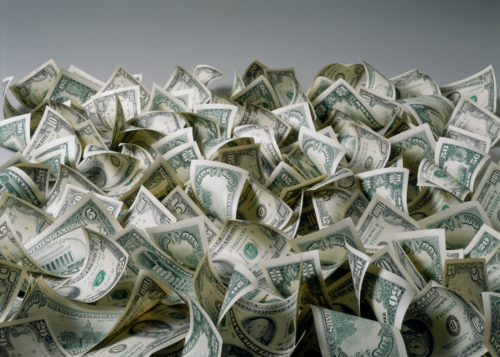Trade Fact of the Week: Trump campaign proposes the highest U.S. tariff since 1937.
By: / 03.27.2024
FACT: Trump campaign proposes the highest U.S. tariff since 1937.
THE NUMBERS: U.S.’ “trade-weighted average tariff”* –
| 2022 | 2.8% |
| 2016 | 1.5% |
| 1990 | 3.3% |
| 1960 | 7.2% |
| 1937 | 15.6% |
WHAT THEY MEAN:
The 2024 election’s core questions are more basic than policy choices. Such as: Can a person who has attempted to overthrow a settled election and called for “termination” of unspecified parts of the Constitution live up to an oath to “faithfully execute the office of President of the United States” and “preserve, protect, and defend the Constitution”? Or: Does the American public endorse a campaign based, as PPI’s President Will Marshall memorably put it last week, on “slandering America as a chaotic hellscape only he can rule”? But this point made, policy choices still have consequences. So here’s one:
The Trump campaign proposes to create a 10% worldwide tariff and a 60% tariff on Chinese goods, probably through a sort of decree. What should we expect from this? A bit of a historic perspective, then a pretty definite result, a very unlikely rationale, and a worst-case scenario:
Context: Highest Tariff Rate Since the Depression: The U.S. International Trade Commission records U.S. trade-weighted tariff averages — that is, “revenue from tariffs divided by goods import value” — going back 134 years, to 1890 and the administration of Pres. Benjamin Harrison. Their most recent figure, for 2022, has $91 billion in tariff revenue and $3.23 trillion in imports for a 2.8% average. This is about twice the 1.2% to 1.5% range before the Trump administration’s “301” and “232” tariffs, imposed in 2018 and 2019. Earlier rates rise steadily as time flows backward, from 3.3% in 1990 to 7.2% in 1960 and higher further back, to a peak of 19.8% in 1933 as Herbert Hoover left office. Rates began to decline as the Roosevelt administration cut tariffs through its Reciprocal Trade Agreements program, to averages of 16.8% in 1936 and 15.6% in 1937. Assuming the campaign’s 10% is (a) added on top of the existing tariff system rather than replacing it, and (b) that its 60% China tariff wouldn’t entirely wipe out U.S.-China trade but leave some continuing under very high taxation, the resulting rate would likely be somewhere around 15%. This would be the highest rate since sometime in the late 1930s.
1. Will Happen: Shift of Taxation Toward Goods-Buyers: One result is very clear. Tariffs are taxes on physical goods brought in from overseas and collected at the border. Tariff-payers are American companies and individuals who buy them. This means a U.S. tax system that relies more heavily on tariffs — in particular if, as campaign literature has suggested, they are used to “offset” revenue losses from lower taxes on corporate and individual incomes — would shift some of the tax burdens. Industries that earn money through financial transactions (e.g. real estate, law firms, financial services) would pay less, while families shopping for goods and businesses that buy and sell goods or use them to make things (e.g. retailers, manufacturers, restaurants, building contractors, repair shops, and farmers) would pay more. This latter effect is magnified, since tariffs generally enable competing local producers to raise their own prices as well.
2. Not Likely to Happen: Policy Rationale Unsupported by Experience: What is the purpose? Essays by former Trump trade officials Peter Navarro in the Heritage Foundation’s “Project 2025” policy book in 2023 and Robert Lighthizer in the Economist this past February, assert that higher tariffs would do two things: first, raise manufacturing output and employment, and second, reduce U.S. trade deficits. Both individuals argued for Trump’s 2018 tariffs on the same grounds. Their hopes did not materialize. To the contrary, with these policies in place manufacturing shrank as a share of GDP, factory employment growth slowed, and trade deficits grew sharply. Here are some data:
a. U.S. manufacturing sector share of GDP: Manufacturing, having been 10.9% of U.S. GDP in 2018, was down to 10.3% in 2021 and likely 10.2% in 2023 pending a final determination by the Bureau of Economic Analysis later this year.
b. U.S. manufacturing employment: Manufacturing job growth averaged 103,000 net new jobs per year in the last five years of the Obama administration, and about half that — 54,000 per year — in the five years since 2018. Note of course a large upheaval in 2020-21 during the Covid pandemic and recovery — a big employment drop in 2020, a big jump in 2021 — so the post-2018 average has some question marks around it.
c. Trade balance: The overall U.S. goods/services trade balance was $479 billion in deficit in 2016. This deficit rose steadily throughout the Trump administration (again with a temporary downturn during the COVID pandemic) to $842 billion in 2021 and $951 billion in 2022 before dropping last year to $773 billion. The manufacturing deficit specifically rose from $0.65 trillion in 2016 to $1.1 trillion in 2022, then $1.05 trillion last year.
3. And a worst-case scenario: In sum, the proposal is to restore late Depression-era trade policy, and shift some taxation away from financialized sectors and upper-income services industries to households and goods-producing or goods-using sectors, in the probably unrealistic hope this would push investment and hiring into manufacturing. To speculate about likely economy-wide results:
Depression-like trade policies need not bring Depression-type outcomes. Modern economic historians tend to view 1930s tariffs as making the Depression somewhat deeper and longer, but root its main causes in other ill-starred ideas: central bank passivity in crisis, refusal to rescue failing banks and lack of deposit insurance, unambitious fiscal policy in the early years, international currency conflicts amplified by the gold standard. With this as a guide, a UK-post-Brexit-like result, with somewhat slower growth and somewhat higher inflation, may be the most likely “macro” outcome of a big tariff increase. Those interested in really dire forecasts, though, can turn to a very well-placed observer on the spot in 1936. Here’s then-President Roosevelt at the “Inter-American Conference on the Maintenance of Peace” in Buenos Aires, reminding us that even if policy choices are not this November’s core questions, they can still matter a lot:
“[T]he welfare and prosperity of each of our Nations depend in large part on the benefits derived from commerce among ourselves and with other Nations, for our present civilization rests on the basis of an international exchange of commodities. Every Nation of the world has felt the evil effects of recent efforts to erect trade barriers of every known kind. Every individual citizen has suffered from them. It is no accident that the Nations which have carried this process farthest are those which proclaim most loudly that they require war as an instrument of their policy. It is no accident that attempts to be self-sufficient have led to failing standards for their people and to ever-increasing loss of the democratic ideals in a mad race to pile armament on armament. It is no accident that, because of these suicidal policies and the suffering attending them, many of their people have come to believe with despair that the price of war seems less than the price of peace.
“This state of affairs we must refuse to accept with every instinct of defense, with every exhortation of enthusiastic hope, with every use of mind and skill. I cannot refrain here from reiterating my gratification that in this, as in so many other achievements, the American Republics have given a salutary example to the world. The resolution adopted at the Inter-American Conference at Montevideo endorsing the principles of liberal trade policies has shone forth like a beacon in the storm of economic madness which has been sweeping over the entire world during these later years. Truly, if the principles there embodied find still wider application in your deliberations, it will be a notable contribution to the cause of peace.”\

FURTHER READING
The U.S. International Trade Commission’s record of U.S. imports, revenue, tariff rates (more precisely, “ad valorem equivalent” rates), etc. from 1890-2022.
Trump campaign tariff primary sources:
Navarro in Heritage’s “Project 2025” (Chapter 26).
Lighthizer in the Economist (subs. req.).
Tariffs and the Depression:
FDR in Buenos Aires.
Contemporary Dartmouth economic historian Douglas Irwin looks back at President Hoover, Sen. Smoot & Rep. Hawley, and the Tariff Act of 1930.
And Charles Kindleberger’s classic on the worldwide Depression economy.
And some statistics:
Trade balance: Both Amb. Lighthizer and Dr. Navarro emphasize trade balance, especially in manufacturing, as a rationale for higher tariffs. Here are the relevant export/import/balance figures for 2016, 2021, and 2023, in total and for manufacturing (NAICS basis) specifically:
| All Goods and Services Trade | Exports | Imports | Balance |
| 2023 | $3.054 trillion – | $3.827 trillion = | -$773 billion |
| 2021 | $3.409 trillion – | $2.567 trillion = | -$842 billion |
| 2016 | $2.241 trillion – | $2.720 trillion = | -$480 billion |
| Manufacturing Only | |||
| 2023 | $1.600 trillion – | $2.674 trillion = | -$1.074 trillion |
| 2021 | $1.403 trillion – | $2.459 trillion = | -$1.056 trillion |
| 2016 | $1.264 trillion – | $1.911 trillion = | -$647 billion |
U.S. monthly trade data from the Census.
… and for the big picture, the Census has U.S. exports, imports, and balances from 1960 to 2023 on one convenient page.
Manufacturing and GDP: BEA’s ‘GDP by Industry’ data series (to be updated a week from Thursday with an initial estimate for full-year 2023), has U.S. output and GDP shares for manufacturing, information, real estate and finance, mining and forestry, agriculture, etc. Try the second table in the Interactive Data Tables for GDP shares.
ABOUT ED
Ed Gresser is Vice President and Director for Trade and Global Markets at PPI.
Ed returns to PPI after working for the think tank from 2001-2011. He most recently served as the Assistant U.S. Trade Representative for Trade Policy and Economics at the Office of the United States Trade Representative (USTR). In this position, he led USTR’s economic research unit from 2015-2021, and chaired the 21-agency Trade Policy Staff Committee.
Ed began his career on Capitol Hill before serving USTR as Policy Advisor to USTR Charlene Barshefsky from 1998 to 2001. He then led PPI’s Trade and Global Markets Project from 2001 to 2011. After PPI, he co-founded and directed the independent think tank ProgressiveEconomy until rejoining USTR in 2015. In 2013, the Washington International Trade Association presented him with its Lighthouse Award, awarded annually to an individual or group for significant contributions to trade policy.
Ed is the author of Freedom from Want: American Liberalism and the Global Economy (2007). He has published in a variety of journals and newspapers, and his research has been cited by leading academics and international organizations including the WTO, World Bank, and International Monetary Fund. He is a graduate of Stanford University and holds a Master’s Degree in International Affairs from Columbia Universities and a certificate from the Averell Harriman Institute for Advanced Study of the Soviet Union.






